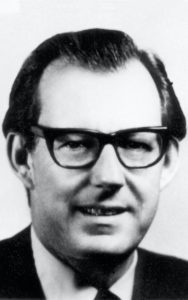William R. Butler (1971-1972)
Thirty-Second President
William R. Butler was the twenty-second man to serve ACPA as president. A native of Robinson, Illinois, Bill Butler was at the time of his election Vice President for Student Affairs and Professor of Education at the University of Miami (Coral Gables, Florida), a position he had held since 1965; was 43 years of age, married to Virginia Ault, and the father of a son and three daughters.
election Vice President for Student Affairs and Professor of Education at the University of Miami (Coral Gables, Florida), a position he had held since 1965; was 43 years of age, married to Virginia Ault, and the father of a son and three daughters.
A native of Robinson, Illinois, Butler attended public schools there through his junior year. He received his diploma in 1944 at Senior High School in Newark, Ohio. After graduation he served in the U.S. Naval Reserves for 27 months, 18 months overseas. After his honorable discharge, he enrolled at Ohio University (OU) where he majored in psychology and received the B.S. (1950, Education) and M.A. (1951) degrees. In October 1970 Butler was the recipient of a Distinguished Alumni Award from OU.
William Butler began his professional career at the University of Kansas (KU) where he was named a Teaching Fellow in the Department of Human Relations (1951-53). Meanwhile at KU he pursued doctoral study in counseling psychology and earned his Ed.D. (1956). Butler served as Assistant Dean of Men and International Student Advisor during 1953-57. He moved to the University of Wisconsin, Milwaukee, as Dean of Men and Assistant Professor, and then he returned to OU with the same titles. Since 1965 he has been Vice President for Student Affairs and Professor of Education at the University of Miami.
Butler’s election to serve as ACPA president during the 1971-72 term represented the culmination of many years of service and professional commitment to ACPA. A member since 1956, he had attended all annual conventions of ACPA and had participated in many of the programs presented at these national conventions.
At the St. Louis convention (1958), Butler delivered a paper entitled “Factor Associated with Scholastic Achievement in High and Low Achieving Fraternities,” an area to which he had devoted much research while pursuing his doctorate in Counseling Psychology at the University of Kansas.
During 1958-59, Butler served on the ACPA Program Committee. At the Cleveland convention (1959), he participated in a demonstration on multiple counseling, while at the Chicago convention (1962), he was involved in a program entitled “Regional Accrediting Agencies— Standard Setters for the College Student Personnel Program,” the latter reflecting his service between 1958 and 1962 as consultant for the North Central Association of Colleges and Secondary Schools.
During the San Francisco convention (1964), Butler served as recorder for a program on Current Issues in the Organization and Administration of Student Personnel Programs. He also chaired a session on New Directions for Fraternities and Sororities and presented a paper entitled “Forces at Work in the Development of Fraternities.”
At the Washington, DC convention (1966), he presented a paper which was later published, “Should College Student Administrators Have Tenure?” That year he became the Coordinator of ACPA’s fourteen national Commissions, and was appointed as one of four members to Study the Structure and Form of the Commissions.
At the Dallas convention (1967), Butler presented his report on the ACPA Commissions to the ACPA Executive Council and recommended that a resolution should be adopted which would outline procedure and policies for the Commissions. His offer to conduct a five-year review of the Commissions’ activities was accepted by the Council and he was subsequently reappointed as Coordinator of the Commissions. Also at this convention, he chaired meetings for the Commission Chairmen and their members, and was a discussant at a program entitled “Current Issues in College Student Personnel Work—As seen by a University President.” At the Detroit convention (1968), Butler summarized the structural history of the ACPA Commissions for the Executive Council and conducted meetings with Commission Chairmen. In that year he was also elected for a three-year term as a member-at-large to the ACPA Executive Council.
As a member of the Executive Council of ACPA, Butler took part in the Council deliberations during its meeting in St. Louis in November 1969. As Chairman of the Executive Council’s Task Force on Professional Issues and Relations, he gave a report relating to the issue of whether or not ACPA should join with NASPA and NAWDC in the formation of a new professional association. This report generated considerable discussion. His motion that the ad hoc Committee on the Future of the Professions consider sponsoring a future convention program on The Future of Our Profession at the ACPA convention in 1970 was passed.
Butler also attended the Executive Council’s meetings in March 1970 held prior to the St. Louis conference (1970). He was recommended to be a member of the group to draft “Model Structures for ACPA-NASPA-NAWDC merger.” Butler’s election as president-elect occurred in that year and was officially announced at the conference in St. Louis.
In September 1970 a meeting was held In Denver to discuss the possible merger of ACPA-NASPA-NAWDC. Since a majority of ACPA Executive Council members were present for the merger deliberations, the actions of the meeting were considered as official business of ACPA. Among the motions introduced and passed was Butler’s to appoint the immediate past-president of ACPA to the APGA Board of Directors as a permanent assignment.
The ACPA Executive council held meetings In Denver again in December 1970 and later in April 1971 prior to the Atlantic City convention. Motions he Introduced and were passed included one that ACPA meet In Chicago in 1972, Cleveland in 1973, Chicago again in 1974, and San Francisco In 1975; also that ACPA forego all of its Business sessions and full programs during the ACPA conventions during those years In question when ACPA would hold its separate conventions.
President Butler was introduced at the ACPA Business session on April 6 in Shannon Hall of the Shelburne Hotel during the Atlantic City convention (1971). He called for the continuation of the amalgamation plans of ACPA with NASPA and NAWDC, while the Executive Council endorsed “in principle” the development of a single national Association. He encouraged the Executive Council to take action toward the implementation of a new project called Tomorrow’s Higher Education” (THE). This project was geared toward the reassessment, re-conceptualization, and redefinition of the mission of the college student personnel profession. Due to the crucial Importance he attached to Project THE and the proposal for a single professional national association, the major thrust of Butler’s leadership was concentrated in these two directions during his year as ACPA President.
President Butler and ACPA President-elect G. Robert Ross met with presidents and presidents-elect of the other two organizations In Chicago In June and November 1971. During these meetings many recommendations of mutual cooperation were made and accepted. These Included the scheduling of joint conventions and concurrent Business sessions held in one common location, the sharing of information about yearly operational budgets of each association, a study on the feasibility of developing a central national office operation serving each of the three associations, and the creation of a single, centralized placement operation to serve the members of all three groups.
By the end of the year, NAWDC, NASPA, and ACPA had agreed on continuing to strengthen mutually-sponsored programs in publications, conventions, the women’s task force, and placement. Also the results of the various feasibility studies and a definitive plan for ACPA’s own future as a professional association would be presented during the Cleveland convention in April 1973.
As the first step in developing this project, President Butler appointed a Task Force composed of leading educators, counselors, and administrators who were vitally concerned with the re-conceptualization of the college student personnel profession. This Task Force proposed a three-phased approach: (1) a descriptive phase stating the fundamental goals and premises of higher education in student development terms, (2) a creative phase in which new conceptual models for future practice would be generated, and (3) an implementation phase witnessing the testing of the re-conceptualized framework on various university campuses through models to be established.
Phase I of Project THE was completed during Butler’s presidential year. An ACPA monograph was published in 1972 which outlined the fundamental goals and premises of higher education in student development terms and provided an analysis and Integrated synthesis of the literature projecting the probable future of higher education. At the end of the year, the promise of Project THE had been fulfilled. Furthermore, through the publication of an ACPA Monograph, this significant contribution was made available to all members of ACPA.
Progress was accomplished in other areas, too. New ACPA state charters were presented, bringing the number of states with ACPA charters to eighteen; a referendum was mailed to 7,000 members of ACPA, which proposed making the Coordinator of Commissions a voting member of the Executive Council, and a proposal was also mailed to promote grassroots participation of ACPA members in the work of the 14 national Commissions. In 1972, a definitive plan of action to open the 14 Commissions for meaningful participation was requested of each Commission. Further, through the work of the ACPA Committee on Continuing Education, a program for Professional Development Workshops was proposed for implementation during the 1972-73 year. An ACPA survey of its 7,000 members was also conducted for the purpose of obtaining the opinions of the members on possible future direction for the Association.
At the end of the 1971-72 year, ACPA membership totaled 7,011 and many of the objectives envisioned early in the term of office had been realized. As outgoing president of ACPA, Butler presided over the Executive Council meetings and the annual Business session in March 1972 during the Chicago convention. Subsequently, William Butler served as an editorial board member of the Journal of College Student Personnel during 1973-76.
Dr. Butler continued to participate in various professional activities at the annual conventions of ACPA after his presidency in 1971-72. Especially, he enjoyed taking part in the former ACPA Presidents’ dinners held each year during the national conventions. He served in various leadership events of ACPA’s Educational Leadership Foundation established in 1994. He was inducted in 1999 as a Diamond Honoree in ACPA’s inaugural class.
Bill Butler’s career in higher education covered a half-century of teaching and administering at four universities (University of Kansas, University of Wisconsin, Milwaukee, Ohio University and the University of Miami). Bill served 32 years as Vice President for Student Affairs and Professor of Education at the University of Miami from 1965 until his retirement in 1997. Throughout his retirement years, he has maintained an active involvement in both student and alumni affairs at U.M. Upon his retirement, the U.M. Board of Trustees named the Student Volunteer Center, established by Bill in 1989, as the William R. Butler Center for Volunteer Service and Leadership Development. In 1997, the U.M. Alumni Association named an annual award in his name that is bestowed upon an alumnus who has demonstrated extraordinary community service. Also, the Butler Atrium in the University’s Wellness Center was named in his honor for his 32 years of service and leadership. In 2008, Buddenbrooks, Inc. in Boston published his book: Embracing the World: The University of Miami from Cardboard College to International and Global Acclaim. This 450 page book returns to the student voices of the 1960s and 70s, and retells the human history of the University of Miami’s 80 years of international and diversity events, programs and leadership.
Bill Butler and his wife, Virginia, have four children and four grandchildren. They make their retirement home in the Village of Palmetto Bay, Florida.
